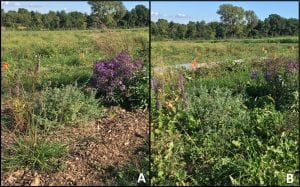Today, Biocontrol Specialist Amara Dunn addresses a common question.
So you want to grow habitat for pollinators…what’s the best method?
The short answer is that there probably isn’t a single best method. But there may be a best method for you. I know it’s not a very satisfying answer, but let me explain.
Remember that an area that provides food and shelter for pollinators (and, incidentally, natural enemies of pests, too!) contains a mix of plant species that bloom throughout the growing season and variation in plant shapes, sizes, and types. Leaving debris from last year’s growth is also helpful. While there are many good reasons to use native plants, non-native plants are ok too, as long as they aren’t invasive. There are plenty of resources out there for choosing plant species for pollinators, like this list of regionally-appropriate plants, and this database that is searchable by zip code. Other databases are searchable by specific plant characteristics.
Once you’ve selected the species you want to use in your pollinator habitat area, you have two main tasks: managing weeds, and establishing the plants. And here’s where the options can start to feel daunting. How will you manage weeds – hand pulling, herbicides, tillage, a cover crop, mulch? This is a critical step in creating habitat for pollinators, and one that is too-often overlooked. Experts recommend that you plan to spend at least one full growing season focused only on this task.
The weed management strategy you choose may also depend on how you would like to establish the plants you have chosen. The two main options are planting seeds directly into the ground, or transplanting small seedlings (or “plugs”). But should you do this in the spring or the fall? In the Northeast United States, experts recommend sowing seeds in the fall. Fall is also a good time to transplant perennials. And it has the advantage of allowing you to spend the entire growing season controlling weeds. But depending on your project timeline, it may not feel like the best option for you.
To help you make informed decisions about the best way to establish habitat for pollinators, I am working with Dr. Betsy Lamb and Brian Eshenaur to measure the costs, labor, and effectiveness of different methods for establishing pollinator habitat. The work is being done in demonstration plots located at Cornell AgriTech at the New York State Agricultural Experiment Station in Geneva, NY. We are comparing six different methods, summarized below.
As you can see, we’ve included a mixture of weed management techniques (cover crop, mulch, mowing, herbicide and tillage, soil solarization) and different plant establishment techniques (seeds vs. plants, spring vs. fall timing). And we’re keeping track of the time and money spent on each method.
You can read more about the details of the methods we’re using and see pictures of our spring planting and seeding on my blog, Biocontrol Bytes. Over the next month or so, we will do our fall seeding. Stay tuned as we finish up the season and calculate inputs of time and money and analyze data collected by NYS IPM’s Bryan Brown on weed management success.
Amara Dunn is the Biocontrol Specialist for the New York State Integrated Pest Management Program, Cornell University, New York State Agricultural Experiment Station, 630 W. North Street, Geneva, NY 14456. Follow her blog, BIOCONTROL BYTE





